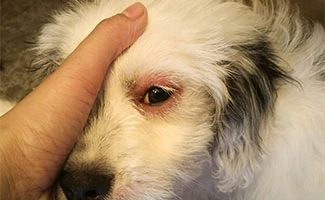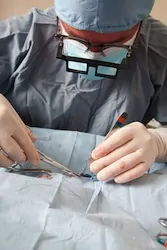To keep the lights on, we receive affiliate commissions via some of our links. Our review process.
Has your dog been diagnosed with cataracts? If so, are you worried about the cumbersome cost of canine cataract surgery? It can be expensive. And if left untreated, this progressive condition can lead to total blindness, so it’s a necessity for your pup’s quality of life.
But how much does dog cataract surgery cost? And how can you reduce your financial burden for unexpected illnesses like this? Here, we’ll give you the info you need to know about dog cataract surgery, the associated costs, and how you may proactively reduce your financial risk for pet vet procedures.
What Are Cataracts In Dogs?
A cataract is a common eye disorder that affects humans as well as our furry friends. A cataract is a cloudy area that forms in the lens of the eye, which is normally clear. The clouding prevents light from passing normally through the lens to the back of the eye. As a result, the cataract can cause blurry vision (and pain if left untreated over time). Dogs (and humans) can develop a cataract in one or both eyes, but the condition is frequent in both eyes.
Are There Breeds That Are More Susceptible?
This condition is usually inherited, and several breeds are more susceptible, including Golden Retrievers, Siberian Huskies, American Cocker Spaniels, Miniature Poodles, Miniature Schnauzers, and Boston Terriers.
What Are The Signs Of Cataracts In Dogs?

Like with human cataracts, dogs develop a cloudy white or gray area over the center of their eye lens. Obviously, this is a tell-tale sign, but there are other symptoms to consider, including:
- Chronic eye redness
- Eye socket inflammation
- Bulging of one eye compared to the other
- Noticeable vision problems, especially in dimly lit conditions
- Squinting
- Pawing at eyes
What Are The Causes Of Canine Cataracts?

Several causes and risk factors can result in cataracts:
- Old age
- Diabetes mellitus
- Electric shock
- Inflammation of the eye’s uvea (uveitis)
- Abnormally low levels of calcium in the blood (hypocalcemia)
How Do You Treat Dog Cataracts?
If you notice any of the symptoms above, it’s important to visit your veterinarian as soon as possible (especially if your dog’s breed is predisposed or elderly).
Your vet will ask for a health history, including the onset of related symptoms, and do a thorough physical exam, focusing on your dog’s eyes. Your vet may also do blood tests and a urinalysis to determine if any diseases could be causing your dog’s condition. If your dog’s diagnosis is diabetes-related cataracts, your vet will first start treatment of this disease to get it under control.
Seeking A Specialist For Support
Most likely, your regular vet will refer you to a veterinary ophthalmologist, who specializes in eye disorders. There are several advanced diagnostic tests the ophthalmologist uses to determine the severity of your pup’s condition and if he needs surgery.
These can include:
- An eye exam using a slit lamp biomicroscope and indirect ophthalmoscope
- Ultrasound or electroretinography (ERG) to examine your dog’s retinas
- CAT scan to visualize all areas in and around his eyes
If your veterinarian recommends cataract surgery, it’s important to act swiftly. There are limited medications, including topical eye ointments or eye drops, which can postpone the need for surgery, but cataracts will not go away without surgery. And cataracts in dogs can progress rapidly.
What’s Involved In Dog Cataract Surgery?

Although stressful for you and your pup, dog cataract surgery is usually uncomplicated and performed on an outpatient basis (meaning your dog can be home with you the same day). Your dog will be put under general anesthesia, and the surgeon will make a small incision into the eye. Then, the surgeon uses a technique called phacoemulsification, in which he uses a small ultrasonic handpiece that breaks up the cataract and aspirates it out of the eye. Then, the surgeon inserts an artificial lens into your dog’s eye to restore his normal vision.
The dog cataract surgery success rate is approximately 90%. Most dogs regain near-normal vision, although many remain slightly farsighted. Most pets’ vision continues to improve over the week following surgery.
How Much Is Cataract Surgery For Dogs?
The cost of cataract surgery for dogs averages $2,700-4,000. This estimate includes the preliminary examination, ERG and ultrasound, surgery, anesthesia, operating room use, hospitalization, initial medications, and postoperative checkups (usually up to 90 days). Surgical costs, however, can vary pretty widely based on your location and service provider.
How Can You Reduce The Cost?

When your dog is young, getting pet health insurance is the best way to plan for health issues throughout your pet’s life. If you sign up while he is young, there are far fewer preexisting conditions that bring the price way down for you. Having pet insurance before the diagnosis can help minimize unexpected expenses for dog cataract surgery and a host of other pet health expenses. It’s not as expensive as you might think. But, you must have an active pet insurance policy in force before diagnosis for that condition to be covered.
Reputable pet insurance companies can help offset most of your pet’s unexpected health expenses. Our experts review the top pet health insurance providers. Read a customer’s testimonial about her experience with her pup, Nacho, who required cataract surgery.
Nacho’s Cataract Surgery Story
Pet Parent: Maryanne
Pet: Nacho, a two-year-old, medium-sized mixed breed
Covered diagnostic tests and treatment: Cataract surgery, including blood work, anesthesia, IV fluids, hospitalization, and pre and post-op medications
Claim cost: $2,667.98
Healthy Paws reimbursement: $2,359.86
Maryanne’s out-of-pocket expense: $308.12 (savings of $2,359.86)
Healthy Paws is amazing! Nacho, our rescue dog who’s only 2-years-old, needed surgery for a cataract that was causing him to go blind. I wasn’t sure if any of the costs would be covered, but thankfully Healthy Paws covered 90% of the surgical expenses. I submitted the claim on Monday and received my check by Saturday!
On top of their quick resolution, Healthy Paws contacted us a week later to follow up on Nacho’s recovery. We were so surprised at their thoughtful gesture! I’m happy to say that Nacho is doing well. I can’t give Healthy Paws enough praise. They are extremely professional, thoughtful, and caring. They treated our dog like their family member, rather than just being another insurance claim. Thank you, Healthy Paws. I highly recommend them if you’re looking for pet insurance. Hopefully, you’ll never need to go through a major health problem with your dog, but if you do Healthy Paws will be there for you!
Video: How Does Cataract Surgery Give Dogs A New Lease on Life?
Watch the video below to see how one “dumpster dog” got much-needed relief from cataract surgery.
Is Dog Cataract Surgery Worth The Cost?
If you don’t want your dog to suffer from a debilitating loss of vision, then it’s worth it. But, before you resign yourself to this costly surgery, schedule an appointment with your vet to learn more. It is possible there may be a less intrusive explanation, especially in younger pups, such as canine conjunctivitis. You can also keep your pup’s eyes protected with dog goggles when they are outdoors for extended periods.
Tagged With: Cost, Eyes, Reviewed By Dr. Racine, DVM
